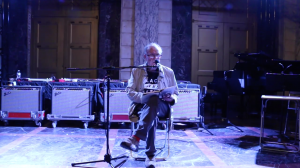A Piece of Music Will Speak Once More. For 26 Hours.
“I am sitting in a room,” Alvin Lucier’s classic work of sound art, will be performed by 90 artists in honor of his 90th birthday.

It was a snowy night in March 1970 in Middletown, Conn. But the composer Alvin Lucier turned off the heat, wanting it quiet in his apartment. He sat in his living room with two tape recorders, a microphone, a single loudspeaker and an amplifier.
Lucier, then 38, with a strong New England accent and a periodic stutter, pressed record and began to speak.
“I am sitting in a room different from the one you are in now,” he said. “I am recording the sound of my speaking voice, and I am going to play it back into the room again and again, until the resonant frequencies of the room reinforce themselves so that any semblance of my speech, with perhaps the exception of rhythm, is destroyed.”
room” — has become one of the classic works of sound art. Lucier repeatedly played and rerecorded his taped voice into his living room. Each recording accumulated more and more of the resonant characteristics of the space.
After roughly nine repetitions of the text — and about 15 minutes — Lucier’s speech, including his stutter, becomes impossible to make out, and is eventually overtaken by high-pitched tones, sounding somewhere between a bowed vibraphone and the creaking of a rusty swing set. By 23 minutes, speech has fully transformed into noisy drones.
At least that’s what one hears in that 1970 recording. Lucier’s work has been performed and recorded many times since then, and every recording sounds different — because how the piece unfolds depends on the particular acoustics of a given space. This range of possibilities will be on display on Thursday — continuing through Friday, Lucier’s 90th birthday — when Issue Project Room in Brooklyn hosts a 26-hour streamed “I am sitting in a room” marathon, featuring 90 performers.
It isn’t the only birthday celebration. On Friday, the Ever Present Orchestra, an ensemble dedicated to Lucier’s music, will premiere his “Adagio for Strings,” streamed by the ZKM Center for Art and Media.

Lucier has long been celebrated as an essential innovator, but he has also remained a bit esoteric. “I really felt as if I had missed the boat in making work that was understood by a lot of the public, not a coterie of cognoscenti,” he said in an email interview.
“One of my fondest compliments,” he added, “was when our plumber, as he was leaving my house after having finished a job at my home, remarked as he was walking out the door: ‘Are you the guy who wrote the piece about sitting in a room? My kids love it. You are ahead of your time.’”
At 90, Lucier’s playful, searching spirit is strong. “I must confess that I am executing crazy ideas I have had in my mind for years but never have had the courage to realize,” he said, including a work inspired by the pianist and composer David Tudor’s “luxurious eyelashes” and “a duet with a bat who lives in the belfry of the Wesleyan Memorial Chapel.”
Over 50 years ago, when Lucier began teaching at Wesleyan University in Middletown, he was already fascinated by environmental and bodily sounds, with works like “Music for Solo Performer” (for amplified brain waves); “Sferics” (for natural radio emissions caused by lightning); and “Chambers” (for resonant spaces ranging from seashells to subway stations). Recording his own body, in his own domestic space, was a logical next step.
One impetus to focus on his voice stemmed in part from his brief stint acting in experimental films. “I’ve started paying attention to the characteristics of my speech which are original to my personality and don’t sound like anybody else’s,” he told an interviewer in 1970. “You know I’m a stutterer.”

Credit…Michael Schroedter and Singuhr E.V.
For composers steeped in the mid-20th-century avant-garde techniques of John Cage, in which personality and self-expression were frowned on — and often actively avoided by using procedures of chance — Lucier’s emphasis on his own voice was a bit taboo.
“Several friends told me they thought it was (too) personal,” he said in the recent written interview. “They meant it as a criticism. You see, indeterminacy was supposed to get us away from such romantic notions. One of my friends confessed that he thought it was ‘self-indulgent.’”
But the intimacy of Lucier’s speaking voice helped ground the piece’s abstract exploration of tape techniques and acoustics, bringing it into dialogue with a broader cohort of musicians who were exploring the musical potential of human speech and repetition around the same time: Steve Reich in “Come Out,”Robert Ashley in “She Was a Visitor,” Pauline Oliveros in “One Word” (from her “Sonic Meditations”).
For over two decades, “I am sitting in a room” circulated mostly through recordings, the first issued in 1970 by the magazine Source: Music of the Avant-Garde; another, from the label Lovely Music, came out in 1981. In 1995, Lucier made his first attempt at performing the piece live, and, in the 2000s, began using computer software to perform it more regularly.
A new box set of archival recordings, issued on the occasion of Lucier’s birthday by Sound on Paper Editions, demonstrates how the music reflects the acoustics of the space in which it’s performed — including a test version made in a small, sterile-sounding room at the Electronic Music Studio at Brandeis University, in 1969, and a rich, reverberant performance at the Church of Saint-Merri in Paris in 2018.
Although the work has long been synonymous with Lucier’s voice and personality, anyone can perform it: The marathon on Thursday and Friday will feature members of his family, students and colleagues performing in various spaces, some of which have been part of the composer’s life. The composer and performer James Fei, a former Lucier student, recorded at the Littlefield Concert Hall at Mills College in California, an institution crucial to the history of experimental (particularly electronic) music and whose future remains uncertain. The composer Paula Matthusen performed the piece in a stairwell at the Center for the Arts at Wesleyan.
“I decided to make my own version that would not be like Alvin’s version,” said the composer George Lewis, who recorded in Berlin. “That’s a very Afro-diasporic thing to do. You sort of find a way. You don’t go with what happened already. You try to create your own version.”
The marathon will begin with a 2017 recording by Lucier, wearing a Black Lives Matter hoodie and reading from his book “Chambers.” His voice is much softer than it was in 1970, and his stutter is almost unnoticeable. In recent years he has begun to face challenges performing because of his health.
 “
“
I am losing my voice because of Parkinson’s disease, which I was diagnosed with about 10 or 12 years ago,” he said.
For his most recent public performance of “I am sitting in a room,” in October 2019, Lucier arrived at the Skanu Mezs Festival in Riga, Latvia, seemingly unable to speak.
“We were really concerned,” said Jan Thoben, the co-editor of the box set, who was serving as technical assistant. “This piece without having a voice, just a whisper: I don’t even know if it would work.”
Lucier recalled that, to prepare for that performance, “I had to warm up my voice beforehand. For some reason I felt strongly that night that I should have my strong voice so that I could give the Riga audience a true version of the work, even though I realized that a whispered version would be authentic, too.”
The Riga recording, featured on the box set, begins tentatively, with the composer quietly repeating the initial “I” in a whisper. After 20 seconds, his voice fills out and, after one false start, continues. The ensuing recording-and-rerecording process reveals bell-like upper frequencies that echo the rhythm of his speech, until the sound gradually smooths into resonant open intervals, sustained by airy, flutelike drones.
The recording is remarkable. And it is also deeply intimate — and intimacy, a sense of being drawn into Lucier’s body and space, was always both the provocation and the enduring draw of “I am sitting in a room.”



